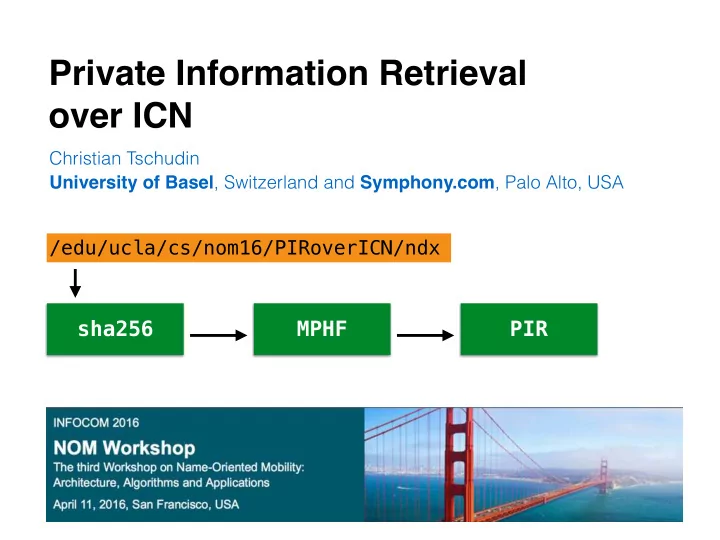

Private Information Retrieval over ICN Christian Tschudin University of Basel , Switzerland and Symphony.com , Palo Alto, USA /edu/ucla/cs/nom16/PIRoverICN/ndx sha256 MPHF PIR
Overview How to lookup secrets over public NDN? /edu/ucla/cs/nom16/PIRoverICN/ndx • Named Data Networking - from packets to data structures sha256 MPHF PIR • Security and Privacy … in many forms • Private Information Retrieval over ICN - a practical protocol • Outlook: going SSL-less - the challenge to secure data structures
From Packets to Services • NDN: usually introduced as Interest/Data packet exchange • Here is another viewpoint: - Interest pkt = DB query - Data pkt = DB reply —> lookup(name) - DNS as a first NDN incarnation • Agenda becomes: “The network is the database” What “things” does such a network store, if not packets?
From Packets to Data Structures • Van’s name hierarchy envisaged “collections” • Recent, more explicit forms: manifests and catalogs - no “discovery”/selectors - can combine elements from different namespace sub-trees - FLIC (File-Like ICN Collection) another example à la UNIX index node • Essential operation on such collections: - lookup by (entry) name —> how can this be made “private”?
Privacy in NDN Signed content envisaged from the beginning, but not enough: Privacy must be supported, enabled, even enforced … • Privacy has many forms: - content privacy (confidentiality as in classical encryption) - intent privacy (encrypted names such that only locator is in the clear) - lookup privacy (topic of this talk) - transport privacy (MIX nets, TOR) - execution privacy (host does not learn anything about algo and result)
Private Index Lookup (and how to retro-fit in into NDN) Inside-out sequence of presentation: /edu/ucla/cs/nom16/PIRoICN/ndx • use “private information retrieval” - needs a position index sha256 MPHF PIR • use Minimal Perfect Hash Functions - maps 256 bits to position 0..N-1 • use SHA256 to normalize names - for classic NDN names {nameless} The_Content - but also “self-certifying names” (e.g. content- or representation-access)
Private Information Retrieval (PIR) • PIR proposed in 1998 - by Chor, Goldreich, Kushilevitz and Sudan - trivial solution (undesired): download full table - non-trivial solutions exist! k servers l • Practical PIR: L L n - information theoretic PIR b a a - relies on two or more non-colluding servers 1 ... k - cloaked queries a a 1 k - servers do a GS(2) matrix mult q q 1 k - client can undo cloaking client
Minimal Perfect Hash Fcts (MPHF) • Looping over a DB’s entries does not scale (to billions, pragmatically) • Replace “ forall i in DB { if (i.key==key) return i; } ” with “ return DB[key2pos(key)] ” • Minimal perfect hash functions: - no collisions - no holes (map N keys to 0…N-1) • How to find a MPHF? - several probabilistic algorithms available (since 1993) - MPHF size “a few bits per entry” - as key we will use the SHA256 of a NDN name … see again the workflow
A Named-Data Protocol for PIR • Publisher has DB L app client lib PIR1 PIR2 publisher init(loc1,loc2) - computes mphf get(mphf) L and mphf - sends it with L to two mphf done non-colluding servers lookup(h) pos=mphf(h) • Client PIR_lookup1(pos) PIR_lookup2(pos) - downloads mphf d1 - cloaks the query d2 d=combine(d1,d2) - requests PIR lookup twice d - combines results OK? No: the two queries (and replies) must be encrypted!
Private Index Lookup (PIL) PIL a useful primitive in NDN • Private walking of the hierarchical namespace dir1 = private_lookup(“/edu/ucla/cs“ + hash(“.”)); // locator dir2 = private_lookup(“/edu/ucla/cs“ + hash(dir1 + "nom16")); dir3 = private_lookup(“/edu/ucla/cs“ + hash(dir2 + "venue")); • FLIC traversing • Other data structures: linked lists, (data structure) trees, …
Going SSL-less • Static names still in use today: - store data (incl keys) in encrypted form and run trusted operations in edge devices • This is what NDNfit does (private fitness data), what Symphony does in the cloud (private messaging) • Long run: untrusted net (as a DB, transport endpoint, computing) SSL means you trust that endpoint - can we avoid this? —> from passive storage to PIR servers, and other forms of waiting for homomorphic encryption… name rewriting (never request the same hash value twice)
Conclusions • Search privacy: “how to lookup secrets over public NDN” • We demonstrate PIR over ICN: specially crafted NDN names • PIR is realistic for NDN (and small tables) today, - more involved for large data structures (files, trees, linked lists, graphs), potentially we loose some privacy • Beyond SSL: secure the data structures , not single pkt flows - need to exploit research results in “structured encryption”
Recommend
More recommend